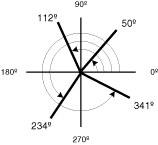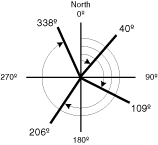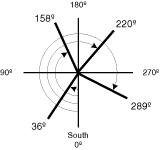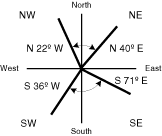Some editing tools allow you to enter an angle, direction, or deflection when creating features. You can change the direction measuring system and units these tools use on the Units tab of the Editing Options dialog box. When you change the direction measuring system and units, the editing tools will all recognize inputs in the new system and units.
Sometimes when creating features using the coordinate geometry tools in ArcMap, you need to convert angles and distances measured in the field so they match the coordinate system of your data. This is known as a ground to grid correction. To learn more, see Applying a ground to grid correction.
Direction measuring systems
You can choose from the following direction measuring systems: north azimuth, south azimuth, quadrant bearing, and polar. By default, the tools accept angular measurements in the polar direction measuring system.
- Polar angles are measured counterclockwise from the positive x-axis.

- In the north azimuth system, the azimuth of a line is the horizontal angle measured from a meridian to the line, measured in the clockwise direction from north.

- In the south azimuth system, the angles are measured clockwise from south.

- In the quadrant bearing system, the bearing of a line is measured as an angle from the reference meridian, either the north or the south, toward the east or the west. Bearings in the quadrant bearing system are written as a meridian, an angle, and a direction. For example, a bearing of N 25 W defines an angle 25 degrees west measured from north. A bearing of S 18 E defines an angle 18 degrees east measured from the south.

- [NS] dd.dddd [EW], where the first letter is an N or S, indicating the meridian of origin, and the last letter is an E or W, indicating the direction of the angle.
- [NS] dd-mm-ss [EW], where the first letter is an N or S, indicating the meridian of origin; the string dd-mm-ss indicates whole degrees, minutes, and seconds with hyphen separators; and the last letter is an E or W, indicating the direction of the angle. Note that this option requires you to set the angular units to quadrant bearing direction type and degrees/minutes/seconds direction units.
- dd.dddd-[1234], where the second-to-last character is a hyphen (-) and the last digit indicates the quadrant in which the bearing is. The quadrants are numbered 1—NE, 2—SE, 3—SW, 4—NW.
Direction measuring units
The editing tools use decimal degrees as their default units of angular measure. You can choose from the following direction measurement units: decimal degrees, degrees/minutes/seconds, radians, gradians, and gons.
- Degrees are the standard unit of angular measurement, where one degree represents 1/360 of a circle and fractions of a degree are represented as decimal values.
- Degrees/Minutes/Seconds also uses the degree, but fractions of a degree are represented in minutes and seconds, where one minute equals 1/60 of a degree and one second equals 1/60 of a minute. Valid input formats for degrees/minutes/seconds values include these:
- dd-mm-ss.ss
- dd.mmssss
- dd^mm'ss.ss"
- Radians are the International System of Units (SI) unit of plane angular measure. There are 2pi, approximately 6.28318, radians in a circle. One radian is equivalent to approximately 57.296 degrees. The length of a circular arc with an angle of one radian is equal to the radius of the arc.
- Gradians are a unit of angular measure where the right angle is divided into 100 parts. One gradian equals 1/400 of a circle.
- Gons are the same as gradians. One gon equals 1/400 of a circle. The term gon is primarily used in German, Swedish, and other northern European languages where the word grad means degree.
Setting the ground to grid correction
When you read the COGO descriptions for boundaries on a survey plan or other legal document, the directions and distances are measured on the surface of the earth. These are referred to as ground measurements. However, the directions and distances in your GIS data are based on the spatial data's coordinate system, or the grid measurements.
Ground and grid measurements are often different. You set constants (the ground to grid correction) for directions and distances so that the software can correctly convert between the ground and grid measurements.
For details, see Applying a ground to grid correction.